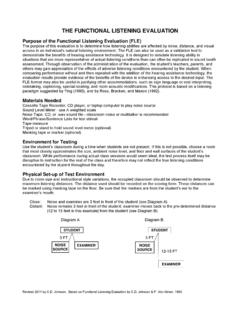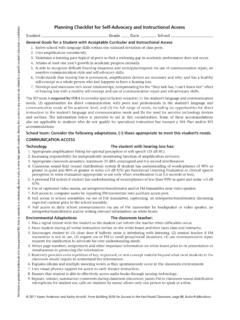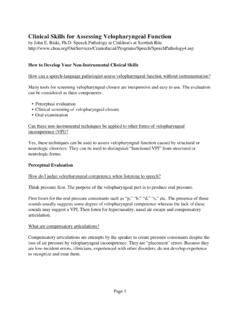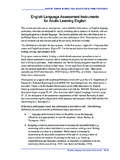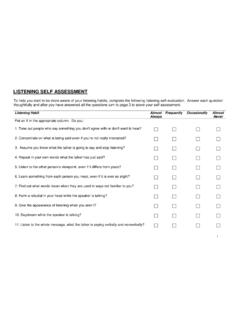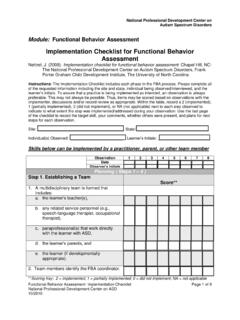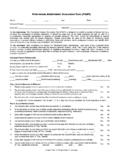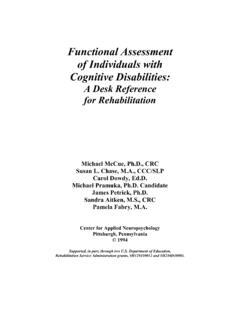Transcription of MI Symp 2008 Deaf Ed Toolkit2 [Compatibility
1 C h e r y lD e C o n d eJo h n s o n ,E d . Educator s ToolkitC h e r y lD e C o n d eJo h n s o n ,E d . h eA DVa n t a gec h e r y l @ c o l o r a d o. e d uToolkit Organization Pre-referral Assessment: Eligibility Assessment: IEP DevelopmentServices and Placement Services and Placement Instruction and Progress Monitoring Inservice/Training/CoachingTiered Levels of SupportSer vices:DHH StudentsIntensive/individualizedSupports (5-10%)TargetedIntensive/Individualized Level Performance more than 2 years delayed Individualized instruction required usually by TODT argeted Level Performance within 1-2 years ofTargetedSupports(20-25%)UniversalSuppo rts(50-65%)
2 Universal Level Performing at or above grade level Consultation/monitoring supportfrom TOD, educational audiologist,or SLP Performance within 1-2 years ofgrade level Special instruction and services,often by TOD with push-in modelPre-Referral Common Behaviors of Children withHearing Loss Classroom management strategies forchildren/youth with hearing losschildren/youth with hearing loss Classroom/Academic Performance Review grades Classroom Teacher s Auditory Performance Scale 36 questions on 6 pt scale listening Conditions Noise QuietIdeal Ideal Multiple Inputs Auditory Memory Sequencing Auditory Attention.
3 PreschoolElementaryElementarySecondaryAs sessment for Eligibility(standardized tests when possible) Audiological Routine assessment BKB-SIN listening in noise, at adistance Aided-Unaided (HearingAid/Cochlear Implant)Academic (Reading, Math, Psycho-Social BASC-2 Connors Rating ScalesRevised Achenbach ChildBehavior Checklist Academic (Reading, Math,Writing) SAT District Achievement Tests Language Receptive & Expressive(English, ASL) Pragmatics VocabularyBehavior Checklist Cognitive/Intellectual WISC-IV UNIT TONI-IIIO ther Eligibility AssessmentsAcademic Woodcock Johnson Kaufman Brigance Batelle CMB IDA Infant Toddler Psycho-social Cognitive/Intellectual IDA Infant ToddlerDevelopmentAssessment AEPS SKI--HI LDS PPVT Rosetti Braken PIAT TAPS Cognitive/IntellectualAssessment for IEP Development Academic (Reading, Math, Writing))
4 Woodcock-Johnson Writing Communication Modes Auditory to Visual Oral to Sign Communication Behavior/Social-emotional Social Skills Rating System/Student Self-Concept Scale Meadow-Kendall listening Skills FAPI, CASLLS Communication Classroom Participation Questionnaire(CPQ) Language & Vocabulary Expanded Curricular Needs Technology Self-advocacy:KIP Leadership Development Deaf Culture ASL Speech Assistive Technology Classroom acoustics Classroom listening Assessment functional listening evaluation Teacher Observation Self-assessment Other assistive technologiesAcademic AssessmentsDeaf Plus HELP Chart (Hawaii Rating Scale ) Brigance (3 levels) CASLLS (Cottage Assessment Scale for Language, listening CASLLS (Cottage Assessment Scale for Language, Listeningand Speech))
5 Total Communication Assessment Communication Matrix AIMS WebCommunication Assessments Modes of Communication Communication Considerations/Communication Plan Clerc Center Nussbaum et al., Scales Communication Access and Participation Communication Access and Participation Classroom Participation QuestionnaireCommunication Considerations(IDEA): IEP team must considerthe child slanguage andcommunicationneeds, opportunities fordirect communicationwithpeer and professional personnel in the child slanguage and communication mode, academiclanguage and communication mode, academiclevel, and full range of needs including opportunities fordirect instructionin the child s language andcommunication mode Consider whether the child requiresassistivetechnology devices and servicesAAvAVVaVAuditoryOnlyAuditoryw/ visualsupportAuditory/Visual(Simultaneou sCommunication)
6 Visualw/auditoryVisualOnlyFunctional CommunicationContinuum-ReceptivesupportC ommunication)auditorysupport 1:1 communication,therapy Small Group Classroom Lecture Classroom-Discussion Classroom-CooperativeLearning Groups Home Car Theater(D. Nussbaum et al, 2006)OOsOSSoSFullyOralMostlyOralOral/ Sign(SimultaneousCommunication)MostlySig nFullySignFunctional CommunicationContinuum-ExpressiveCommuni cation)Sign Communication partners Communication ease Preferred communicationmodeConsiderations(D. Nussbaum et al, 2006)ColoradoDepartment ofEducationIEPC ommunicationCommunicationPlanClassroom ParticipationQuestionnaire(Antia, Sabers, & Stinson, 2007)
7 Self-assessment of access to teacher and peercommunication in classroom 4 areas Understanding teacher Understanding teacher Understanding students Positive effect Negative effect Counseling toolCPQ Sample QuestionsI understand my teacher when she give me understand my teacher when she answers other student understand the other students in class during join in class feel good about how I communicate in feel relaxed when I talk to my feel frustrated because it is difficult for me to communicatewith other get upset because other students cannot understand get upset because my teacher cannot understand ParticipationQuestionnaireN=263, CIPP, Assessment Vocabulary PPVT EOWPVT ROWPVT TERA-3 (Test of Early Language (continued) REEL-2 Reynell PLS-4 CELF and CELF-PReading Ability-3rdedition) Language TACL-3 CASLLS (CottageAcquisition Scales forListening, Language andSpeech) SALT OWLS SKI-HI LanguageDevelopment Scale GAEL & GAEL-P TAGS PragmaticsBehavioral/Social-emotional.
8 Social SkillsRating System (SSRS) 3 Areas Academic Performance Social Skills Problem Behaviors 3 Reporter Options Parent Teacher Self-Report 3 Levels Preschool School-age: Elementary School-age SecondarySocial Skills Rating System (SSRS)(Gresham & Elliot, 1990) Teacher Formdocuments teacher sperceived frequency and importance ofbehaviors influencing student s developmentofof Social Skills Problem Behaviors Academic Performance Yields a standard score of 100, SD examples Social Skills Controls temper Invites others to joinactivities Initiates conversationwith peers Problem Behaviors Has low self-esteem Disturbs ongoingactivities Gets angry easilywith peers Follows your directions Likes to be aloneTeacher Rated Social SkillsOver Time60708090100 PercentofStudents01-02 (N=160)02-03 (N=155)03-04 (N=145)04-05 (N=144)
9 05-06 (N=120)0102030405060 BelowAverageAverageHighPercentofStudents 05-06 (N=120)Teacher Rated Problem BehaviorOver Time5060708090100 PercentofStudents01-02 (N=162)02-03 (N=154)03-04 (N=149)04-05 (N=144)05-06 (N=121)01020304050 BelowAverageAverageHighPercentofStudents Social Behavior Summary Social skills and problem behaviors of students instudy are similar to those of typical studentpopulation. As students in study increased in age, social skillsand problem behaviors remained comparable toand problem behaviors remained comparable totypical student population. Older students were not rated as more socially withdrawn orisolatedListening Skills Assessment functional Auditory Performance Indicators (FAPI) Early Speech Perception Test (ESP) for Profoundly DeafChildren Lexical Neighborhood Test (LNT) & Multi-syllabicLexical Neighborhood Test (MLNT)Lexical Neighborhood Test (MLNT) Meaningful Auditory Integration Scale (MAIS)/InfantToddler (IT-MAIS) Developmental Index of Audition and listening (DIAL) listening Inventory for Education ( )
10 listening Development ProfileListeningDevelopmentProfile(adapt ed from(adapted fromRizaRizack,1994)Speech AssessmentSuprasegmental, phonetic, phonological development Arizona Articulation Proficiency Scale-3rdEdition(articulation) Goldman Fristoe: Test of Articulation 2 (articulation) Ling Phonetic-Phonologic Speech evaluation Record(segmental and nonsegmental aspects of speech at(segmental and nonsegmental aspects of speech atphonetic and phonological levels) Cottage Acquisition Scales for listening , Language, andSpeech (developmental checklist and curriculum forphonetic-phonological speech evaluation ) CID Picture Speech Intelligibility evaluation (SPINE) PAT Photo Articulation TestAssistive Technology Assessment.))
